When it comes to maintaining your motorcycle, you can't afford to overlook the essentials. Regular inspections and preventative measures not only keep your ride safe but also enhance its performance. You'll want to focus on vital areas like oil changes, tire pressure, and brake system checks to guarantee everything runs smoothly. But there's more to it than just these basics—understanding your bike's specifications and addressing common issues can make a significant difference. So, what are the top practices you should adopt to keep your motorcycle in peak condition? Let's explore.
Key Takeaways
- Perform regular inspections to catch potential issues early, enhancing safety and reliability while saving on costly repairs.
- Maintain proper tire pressure and tread depth for improved grip, stability, and overall riding safety.
- Change engine oil every 3,000 to 5,000 miles and replace filters to ensure engine efficiency and longevity.
- Regularly check the brake system and fluid levels to ensure effective stopping power and prevent brake failure.
Understanding Ducati Specifications
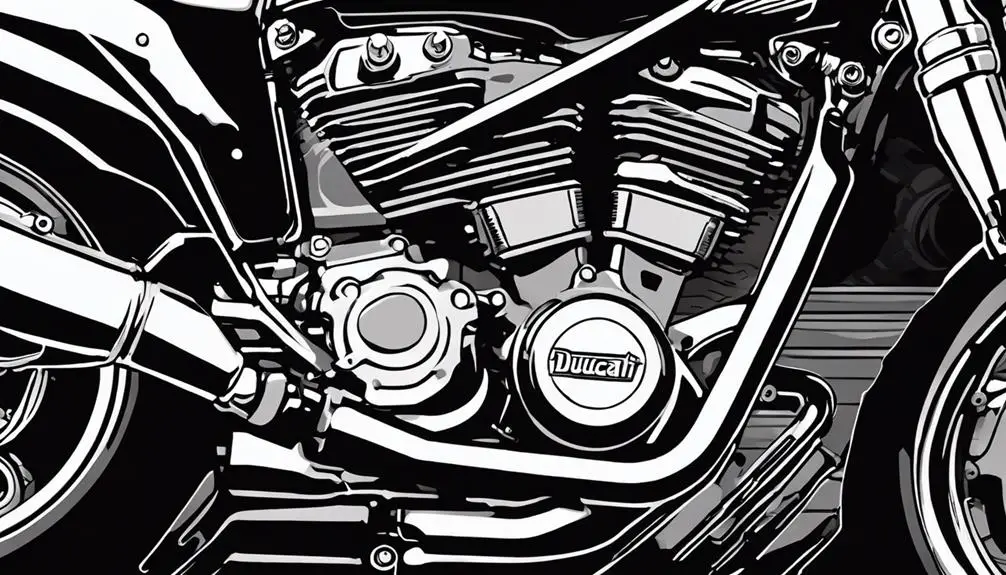
To keep your Ducati running smoothly, you need to understand its specific requirements and performance specifications. Each model has unique characteristics that define its performance and handling. Familiarize yourself with the engine type, displacement, and torque ratings, as these factors influence how your bike accelerates and responds to your commands.
Next, check the recommended fuel type. High-performance machines like Ducatis often require premium fuel to release their full potential. Don't ignore the importance of maintaining the right tire pressure and tread depth, as these directly affect your grip and stability on the road.
You should also pay attention to the recommended oil type and change intervals. Using the right oil guarantees your engine operates at peak efficiency, keeping it free from unnecessary wear and tear.
Lastly, familiarize yourself with the electrical system, including the battery specifications. A healthy battery is essential for reliable starts and peak performance.
Importance of Regular Inspections
Regular inspections are essential for keeping your motorcycle in top shape and ensuring your safety on the road.
By catching potential issues early, you can save money on repairs and avoid breakdowns.
Plus, knowing your bike is in good condition gives you peace of mind while riding.
Preventative Maintenance Benefits
Routine inspections are essential for catching potential issues before they escalate, ensuring your motorcycle remains safe and reliable on the road. By regularly checking your bike, you're taking control of its performance and longevity. It's not just about fixing problems; it's about preventing them.
Think of your motorcycle as an extension of your freedom. When you maintain it well, you're ensuring that every ride is smooth and exhilarating. You don't want to be sidelined by unexpected breakdowns or costly repairs. Regular inspections help you identify worn tires, leaking fluids, or a weak battery before they ruin your ride.
Plus, these check-ups give you a chance to connect with your bike. You'll get to know its quirks and nuances, allowing you to ride with confidence. This proactive approach not only enhances your bike's performance but also contributes to your overall riding experience.
Safety Assurance Importance
Guaranteeing your motorcycle is safe to ride hinges on consistent inspections that catch potential hazards before they lead to serious accidents.
Regular checks empower you to maintain your freedom on the open road while guaranteeing your ride is reliable and safe.
Here are four key areas to focus on during your inspections:
- Brakes: Always check brake pads and fluid levels. Effective brakes are essential for your safety and can make the difference in emergencies.
- Tires: Inspect tire pressure and tread depth. Properly inflated and well-maintained tires guarantee better grip and handling, fundamental for confident riding.
- Lights: Test all lights, including headlights, tail lights, and turn signals. Visibility is critical, both for you and for others on the road.
- Fluid Levels: Regularly check oil, coolant, and brake fluid. Maintaining these levels keeps your engine running smoothly and prevents overheating or failure.
Keeping Your Oil Fresh
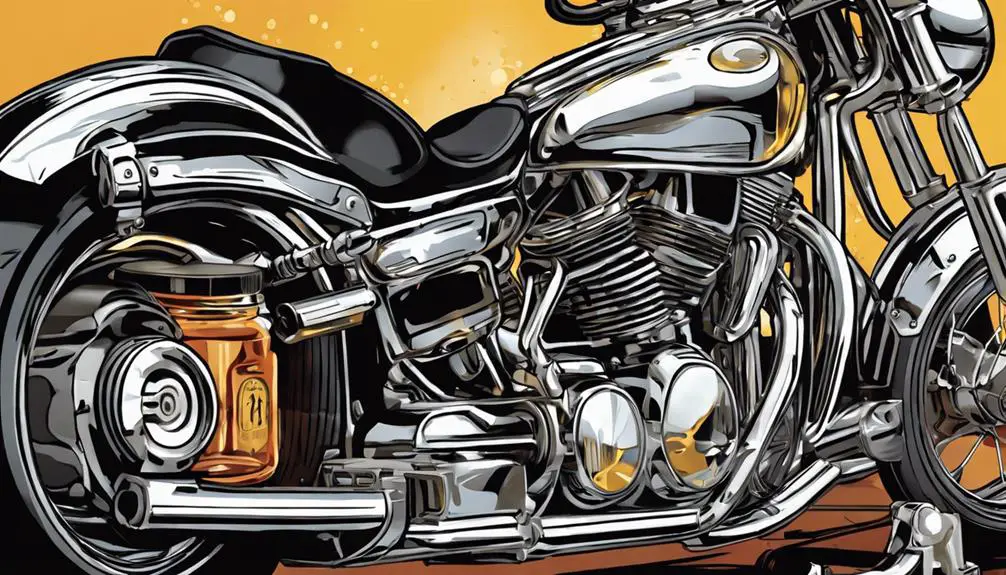
Fresh oil is essential for your motorcycle's performance, so it's important to check and change it as needed. Oil lubricates your engine, reduces friction, and helps keep temperatures down. Neglecting it can lead to costly repairs and hinder your ride's freedom.
Start by checking the oil level using the dipstick. If it's low, top it off with the right type of oil for your bike. Make it a habit to check your oil every few rides, especially before long trips.
Changing your oil regularly—every 3,000 to 5,000 miles—is a must. Old oil can become gritty and lose its effectiveness, so don't wait until it's too late. When you change it, remember to replace the oil filter too; it traps debris and keeps your oil clean.
After draining the old oil, verify you dispose of it properly. Many auto shops accept used oil for recycling.
Tire Maintenance Essentials
Tire maintenance is essential for your safety and performance on the road.
You should check your tire pressure regularly and inspect the tread depth frequently to guarantee ideal grip and handling.
Keeping an eye on these essentials can prevent accidents and extend the life of your tires.
Check Tire Pressure Regularly
Regularly checking your motorcycle's tire pressure is essential for safe and efficient riding. Properly inflated tires not only enhance your control but also improve fuel efficiency and extend tire life.
Here are some tips to guarantee you keep your tires in top shape:
- Check Pressure Weekly: Make it a habit to check your tire pressure at least once a week, especially before long rides. This simple task can prevent dangerous blowouts.
- Use a Reliable Gauge: Invest in a good quality tire pressure gauge. Digital gauges are often more accurate and easier to read than manual ones.
- Know Your PSI: Familiarize yourself with your motorcycle's recommended tire pressure, typically found in the owner's manual or on a sticker near the tire.
- Adjust for Conditions: Remember that temperature changes can affect tire pressure. Adjust accordingly, especially when riding in extreme heat or cold.
Inspect Tread Depth Frequently
Inspecting your motorcycle's tread depth is essential for ensuring ideal traction and safety on the road. Worn tires can lead to skidding, especially in wet or slippery conditions, which can rob you of the freedom that riding brings. To maintain that exhilarating ride, you've gotta check your tread depth regularly.
Use the penny test: insert a penny into the tread grooves with Lincoln's head facing down. If you can see all of Lincoln, it's time to replace those tires. Aim for at least 1/16 of an inch of tread depth to maintain grip and control.
Don't just do this once; make it a part of your routine maintenance. Check your tires before long rides or after any significant mileage. Keep an eye out for uneven wear, which can signal alignment issues or improper inflation.
Brake System Care
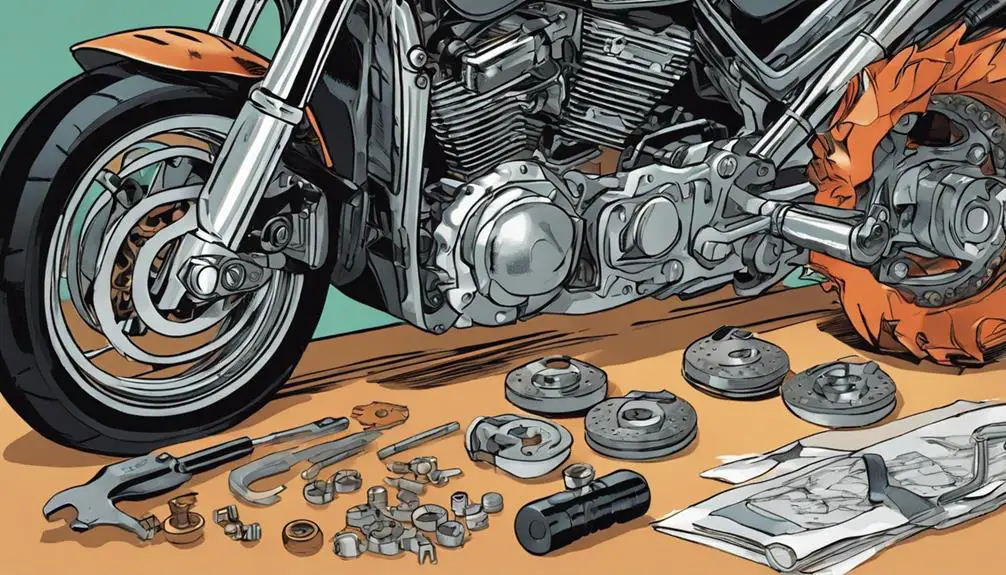
Your motorcycle's brake system is essential for safety, so keeping it in top shape should be a priority. A well-maintained brake system not only enhances your riding experience but also allows you to embrace the open road with confidence.
Here are some key tips to guarantee your brakes are always ready to perform:
- Check Brake Fluid Levels: Regularly inspect your brake fluid reservoir. Low fluid can lead to brake failure, so keep it topped up.
- Inspect Brake Pads: Look for wear and tear on your brake pads. If they're worn down, replace them immediately to maintain effective stopping power.
- Test Brake Functionality: Periodically squeeze your brake levers to guarantee they engage smoothly. If you feel any grinding or unusual resistance, it's time for a check-up.
- Watch for Leaks: Keep an eye out for any fluid leaks around your brake calipers and lines. Addressing leaks early can prevent more significant issues down the road.
Chain and Sprocket Management
Maintaining a clean and well-lubricated chain is essential for ensuring smooth power transfer and prolonging the life of your motorcycle's sprockets. A dirty or dry chain can lead to poor performance and increased wear, which can ultimately hold you back on the open road.
Start by inspecting your chain regularly for dirt and grime. If it's looking grimy, use a chain cleaner and a brush to scrub away the debris. Rinse it off thoroughly and let it dry. Once clean, apply a quality chain lubricant, focusing on the inner links while avoiding overspray on the rubber components of your bike.
Check the chain tension frequently. An overly tight or loose chain can affect handling and increase wear on both the chain and sprockets. Ideally, you should maintain the manufacturer's specified tension.
Lastly, inspect your sprockets for signs of wear or damage. If you notice hooked teeth or excessive wear, it's time to replace them. A well-maintained chain and sprocket system not only enhances your ride but also empowers you to fully enjoy the freedom of the road.
Keep your machine in top shape, and let the adventure begin!
Electrical System Checks
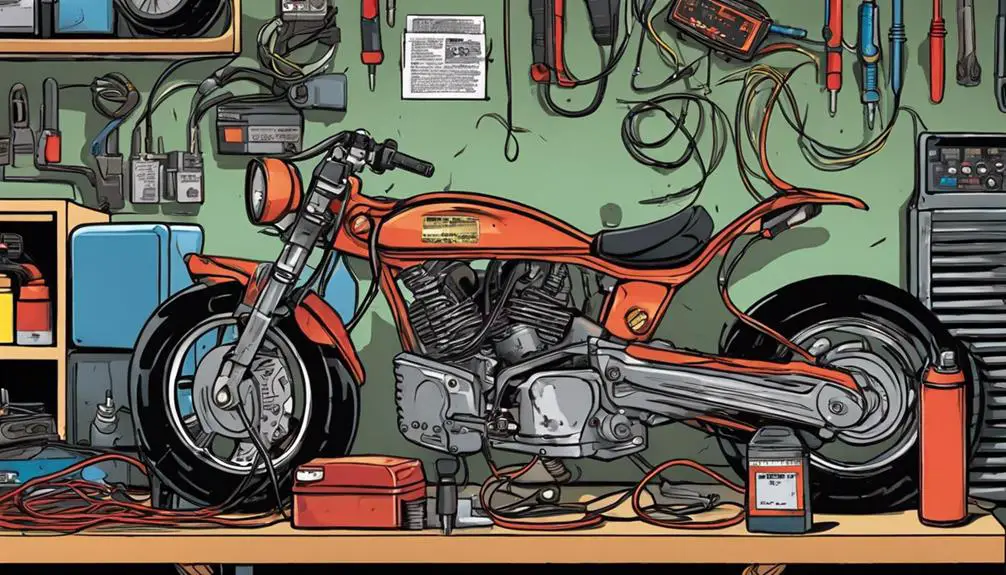
Regularly checking the electrical system guarantees that everything—from your battery to the lights—functions smoothly and reliably on your rides. A well-maintained electrical system keeps you connected to the freedom of the open road. Here are some essential checks you should perform:
- Battery Voltage: Use a multimeter to check your battery's voltage. A healthy battery should read around 12.6 volts when fully charged. If it drops below 12.4, consider charging it.
- Connections: Inspect all electrical connections for corrosion or loose wires. Tighten any loose connections and clean any corrosion to maintain a solid flow of electricity.
- Fuses: Check your fuses regularly. A blown fuse can disrupt critical systems. Replace any faulty fuses with the correct rating to maintain peak function.
- Lights: Test your headlights, brake lights, and turn signals. Regularly inspect the bulbs for any signs of wear and replace them promptly to stay visible to others.
Cleaning and Detailing Tips
Keeping your motorcycle clean not only enhances its appearance but also helps prevent corrosion and damage over time. Start by gathering the right supplies: a gentle motorcycle-specific cleaner, microfiber cloths, and brushes for those hard-to-reach spots.
Begin by rinsing your bike with water to remove loose dirt. Apply the cleaner, working from the top down to avoid dripping onto already cleaned areas. Use a soft brush to scrub away stubborn grime, particularly around the wheels and chain. Don't forget to pay attention to the undercarriage, where dirt often accumulates unnoticed.
Rinse thoroughly and dry your motorcycle with a microfiber cloth to prevent water spots. For added protection, consider applying a wax or polish designed for motorcycles. This not only shines but creates a barrier against the elements.
Lastly, clean your bike's chrome parts with a dedicated polish to maintain that gleaming finish. Regular detailing not only keeps your ride looking sharp but also empowers you to embrace the freedom of the open road with pride. After all, a well-maintained motorcycle fuels both your spirit and your adventures.
Seasonal Storage Practices
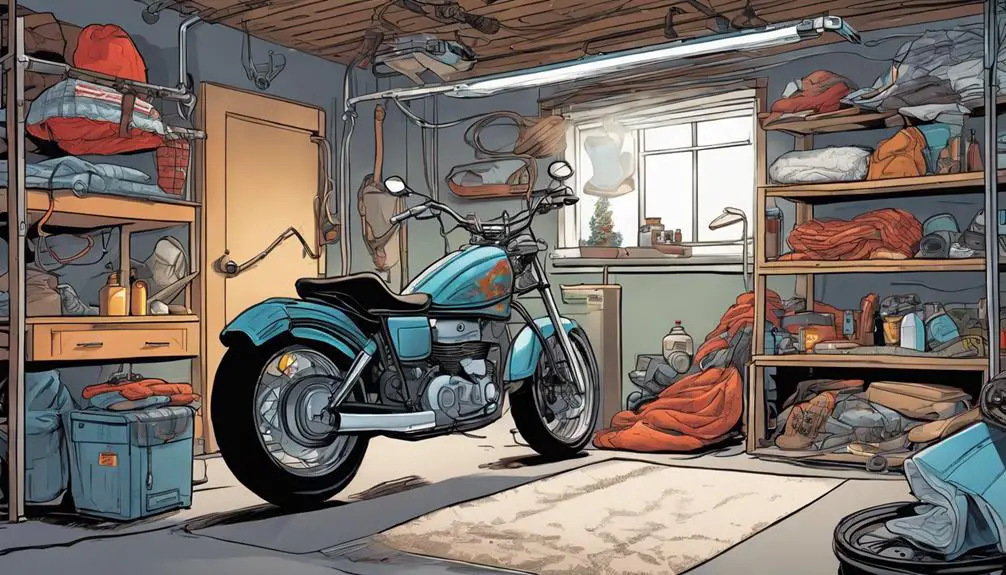
Proper seasonal storage can greatly extend your motorcycle's lifespan and performance. When it's time to tuck your bike away, follow these essential practices to guarantee it's ready for your next ride.
- Fuel Stabilization: Fill up the tank and add a fuel stabilizer. This prevents the fuel from breaking down and clogging your system.
- Battery Maintenance: Disconnect and remove the battery. Store it in a cool, dry place and consider using a trickle charger to keep it topped off.
- Tire Care: Inflate your tires to the recommended pressure to prevent flat spots. If you can, elevate the bike on a stand to keep the tires off the ground.
- Cover It Up: Use a breathable cover to shield your bike from dust and moisture. Avoid plastic covers that can trap humidity and cause corrosion.
Taking these steps won't only protect your ride but also keep the spirit of freedom alive and kicking.
When the season changes, you'll be ready to hit the open road with confidence!
Recognizing Common Issues
Spotting common motorcycle issues early can save you time and money, ensuring your ride remains safe and enjoyable.
Pay attention to any unusual sounds, like knocking or grinding—these can signal problems with your engine or transmission. If you notice a decrease in acceleration or a sluggish response, it might be time to check your throttle or fuel system.
Don't ignore warning lights on your dashboard. They're your bike's way of communicating potential issues, whether it's low oil, battery problems, or issues with your brakes.
Regularly inspect your tires for wear and proper pressure; uneven wear can affect handling and safety.
Check your brakes frequently. If they feel spongy or you hear squeaking, it's vital to address it right away to avoid dangerous situations.
Look for leaks around your bike, especially in the oil and coolant systems—fluid leaks can lead to bigger, more costly repairs.
Frequently Asked Questions
How Often Should I Wash My Motorcycle?
You should wash your motorcycle every two weeks, or more often if you ride in harsh conditions.
Keeping it clean doesn't just make it look good; it helps prevent rust and corrosion.
Pay attention to the chain and other critical parts, as dirt can cause wear.
Use gentle soap and avoid harsh chemicals to protect the finish.
Regular washes keep your ride in top shape, ensuring you enjoy every freedom-filled journey.
Can I Use Car Products on My Motorcycle?
Using car products on your motorcycle is like dressing a lion in a sheep's coat; it mightn't fit right.
While some products overlap, many car cleaners and waxes can harm your bike's finishes or components.
Your motorcycle deserves specialized care, so stick to products designed for its unique materials.
Embrace the freedom of knowing you're treating your ride with the respect it deserves, ensuring it performs at its best for every adventure.
What Are the Signs of a Failing Battery?
When your battery's failing, you might notice a few key signs. Your bike may struggle to start, or you could see dim lights.
If you hear clicks instead of the engine firing up, that's another warning. You might also experience electrical issues, like gauges acting erratically.
Keep an eye on these symptoms; catching them early can save you from being stranded. Trust your instincts and don't ignore the signs.
Is It Necessary to Warm up the Engine Before Riding?
You're revved up, ready to hit the open road, but should you warm up your engine first?
While some riders swear by it, modern engines often don't need much time to warm up. Just a minute or two can get the oil circulating, but don't let it idle too long—freedom awaits!
Trust your instincts, listen to your bike, and soon you'll feel the thrill of the ride.
Let the adventure begin!
How Do I Properly Break in a New Motorcycle?
To properly break in your new motorcycle, you'll want to vary your speed and avoid long periods at a constant RPM.
For the first 500 to 1,000 miles, keep the engine below 5,000 RPM and gradually increase your speed. This helps the engine parts wear in smoothly.
Don't forget to change the oil and filter after the break-in period to guarantee everything runs freely.
Enjoy the ride and feel the freedom!
Conclusion
In the world of motorcycle maintenance, a little effort can go a long way.
While it's easy to overlook those small checks, skipping them can lead to costly repairs down the road.
By staying proactive, you can enjoy the thrill of the ride without the anxiety of unexpected breakdowns.
So, balance routine upkeep with your love for the open road, and your bike will reward you with smooth journeys and unforgettable adventures.
Keep riding, keep shining!